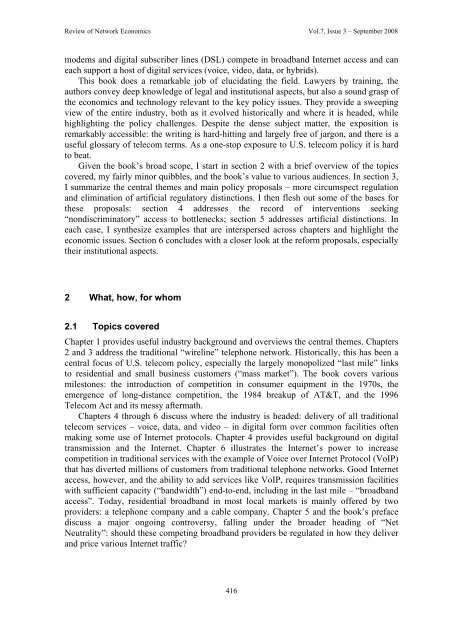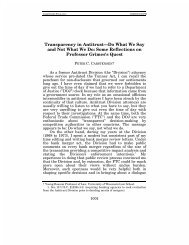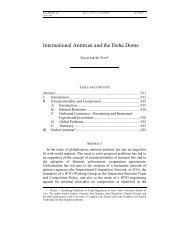An Essay Review of Nuechterlein and Weiser's Digital Crossroads
An Essay Review of Nuechterlein and Weiser's Digital Crossroads
An Essay Review of Nuechterlein and Weiser's Digital Crossroads
- No tags were found...
Create successful ePaper yourself
Turn your PDF publications into a flip-book with our unique Google optimized e-Paper software.
<strong>Review</strong> <strong>of</strong> Network Economics Vol.7, Issue 3 – September 2008<br />
modems <strong>and</strong> digital subscriber lines (DSL) compete in broadb<strong>and</strong> Internet access <strong>and</strong> can<br />
each support a host <strong>of</strong> digital services (voice, video, data, or hybrids).<br />
This book does a remarkable job <strong>of</strong> elucidating the field. Lawyers by training, the<br />
authors convey deep knowledge <strong>of</strong> legal <strong>and</strong> institutional aspects, but also a sound grasp <strong>of</strong><br />
the economics <strong>and</strong> technology relevant to the key policy issues. They provide a sweeping<br />
view <strong>of</strong> the entire industry, both as it evolved historically <strong>and</strong> where it is headed, while<br />
highlighting the policy challenges. Despite the dense subject matter, the exposition is<br />
remarkably accessible: the writing is hard-hitting <strong>and</strong> largely free <strong>of</strong> jargon, <strong>and</strong> there is a<br />
useful glossary <strong>of</strong> telecom terms. As a one-stop exposure to U.S. telecom policy it is hard<br />
to beat.<br />
Given the book’s broad scope, I start in section 2 with a brief overview <strong>of</strong> the topics<br />
covered, my fairly minor quibbles, <strong>and</strong> the book’s value to various audiences. In section 3,<br />
I summarize the central themes <strong>and</strong> main policy proposals – more circumspect regulation<br />
<strong>and</strong> elimination <strong>of</strong> artificial regulatory distinctions. I then flesh out some <strong>of</strong> the bases for<br />
these proposals: section 4 addresses the record <strong>of</strong> interventions seeking<br />
“nondiscriminatory” access to bottlenecks; section 5 addresses artificial distinctions. In<br />
each case, I synthesize examples that are interspersed across chapters <strong>and</strong> highlight the<br />
economic issues. Section 6 concludes with a closer look at the reform proposals, especially<br />
their institutional aspects.<br />
2 What, how, for whom<br />
2.1 Topics covered<br />
Chapter 1 provides useful industry background <strong>and</strong> overviews the central themes. Chapters<br />
2 <strong>and</strong> 3 address the traditional “wireline” telephone network. Historically, this has been a<br />
central focus <strong>of</strong> U.S. telecom policy, especially the largely monopolized “last mile” links<br />
to residential <strong>and</strong> small business customers (“mass market”). The book covers various<br />
milestones: the introduction <strong>of</strong> competition in consumer equipment in the 1970s, the<br />
emergence <strong>of</strong> long-distance competition, the 1984 breakup <strong>of</strong> AT&T, <strong>and</strong> the 1996<br />
Telecom Act <strong>and</strong> its messy aftermath.<br />
Chapters 4 through 6 discuss where the industry is headed: delivery <strong>of</strong> all traditional<br />
telecom services – voice, data, <strong>and</strong> video – in digital form over common facilities <strong>of</strong>ten<br />
making some use <strong>of</strong> Internet protocols. Chapter 4 provides useful background on digital<br />
transmission <strong>and</strong> the Internet. Chapter 6 illustrates the Internet’s power to increase<br />
competition in traditional services with the example <strong>of</strong> Voice over Internet Protocol (VoIP)<br />
that has diverted millions <strong>of</strong> customers from traditional telephone networks. Good Internet<br />
access, however, <strong>and</strong> the ability to add services like VoIP, requires transmission facilities<br />
with sufficient capacity (“b<strong>and</strong>width”) end-to-end, including in the last mile – “broadb<strong>and</strong><br />
access”. Today, residential broadb<strong>and</strong> in most local markets is mainly <strong>of</strong>fered by two<br />
providers: a telephone company <strong>and</strong> a cable company. Chapter 5 <strong>and</strong> the book’s preface<br />
discuss a major ongoing controversy, falling under the broader heading <strong>of</strong> “Net<br />
Neutrality”: should these competing broadb<strong>and</strong> providers be regulated in how they deliver<br />
<strong>and</strong> price various Internet traffic<br />
416





